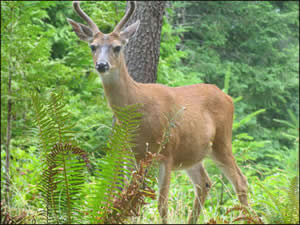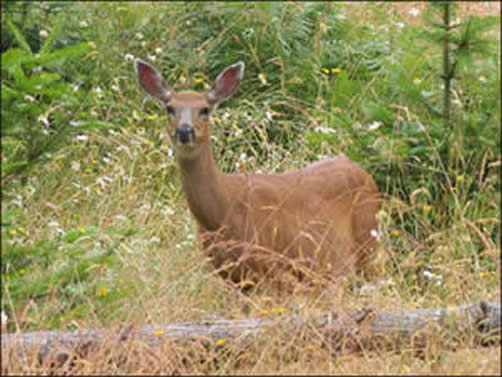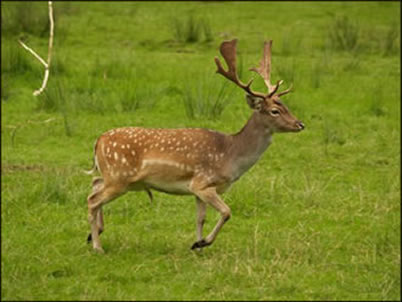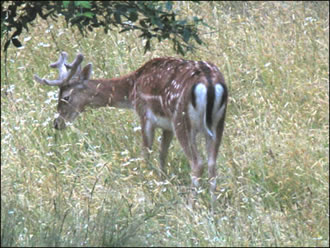Fallow Deer
Introduction
-
The European fallow deer (Dama dama) and the Columbian black-tailed deer (Odocoileus hemionus columbianus) are common inhabitants of Mayne Island. The black-tailed deer, a subspecies of mule deer are indigenous to western North America. They inhabit the temperate coniferous forest regions from northern California into the Pacific North West and coastal BC. Fallow deer originated in the eastern Mediterranean region of southern Europe and Iran and possibly North Africa and are considered an invasive species in Canada. They were introduced into many western countries for sporting purposes as well as farming and are a prized source of venison.
Physical characteristics
Fallow deer display the most variable colouration of any deer species. The summer coat in the most typical form is a light reddish brown with white spots scattered over the back and sides and a horizontal row of spots that can merge into a single line along each side. There may also be a narrow dorsal stripe from neck to tail. The other main colour phases are a non-spotted creamy or buff white and a dark brown. A small white rump patch with a heart-shaped black border is distinctive of fallow deer. Fallow deer are the only deer in BC in which adults may have a spotted coat. The average weight of mature males is 67 kg while females weigh in at around 44 kg. The antlers of the male are broad and shovel-shaped (palmate). The longevity of fallow deer in BC is unknown but thought to be at least 18 years.
Male Fallow Deer Photo below by
Johann-Nikolaus Andreae
Reproduction
Female Fallow deer reach sexual maturity at around 18 months of age. Males, although biologically able to breed at an age of 17 months, may not sire their first offspring until 3 to 5 years due to competition from more mature and aggressive bucks. The breeding season runs for about 135 days from September to January. Does in BC generally give birth to a single fawn in May or June after a gestation period of approximately 230 days.
Photo of Female Fallow by Richard Bartz
Feeding:
Fallow deer are grazers feeding on grasses by preference. If food availability is low they adapt feeding to include greater amounts of broad-leafed plants including herbs, shrubs, leaves, buds, shoots, and bark. They have been described as voraciously indiscriminate browsers. Evidence of heavy browsing is shown by a distinct browse line on the trees.
Black Tail Deer
Physical characteristics
Black-tailed deer have a greyish brown coat in winter which is reddish brown in summer. While the belly is the same colour as the rest of the body, the insides of the legs are lighter. There is a dark brown cap on the forehead and a white patch below the throat and on the rump. Mature body weight average is 55 kg and 46 kg for males and females, respectively. The antlers are forked and multi-tined with points. A lifespan of more than 10 years is uncommon and most live no longer than 4 or 5.

Photo of Male Black-tailed deer
Reproduction
Black-tailed does are usually ready for breeding at the age of 18 months and give birth after an average of 203 days of gestation. Twins are the rule, particularly in years subsequent to the first birthing, and generally arrive in May or June. Breeding begins in late October. Bucks, although capable of breeding at 18 months of age often do not have their first chance to participate in the rut until 3 to 5 years of age.

Photo of Female Black-tailed deer
Feeding:
Black-tailed deer are primarily browsers preferring the leaves and twigs of such plants as Douglas fir, Saskatoon, willows, blackberry, salal, and Western red cedar.
Both species are active mainly nocturnally with peak periods at dawn and dusk.
Note: Fallow and Black-tailed deer belong to different species. Inter breeding does not take place between Fallow and Black-tailed deer.



.jpg)